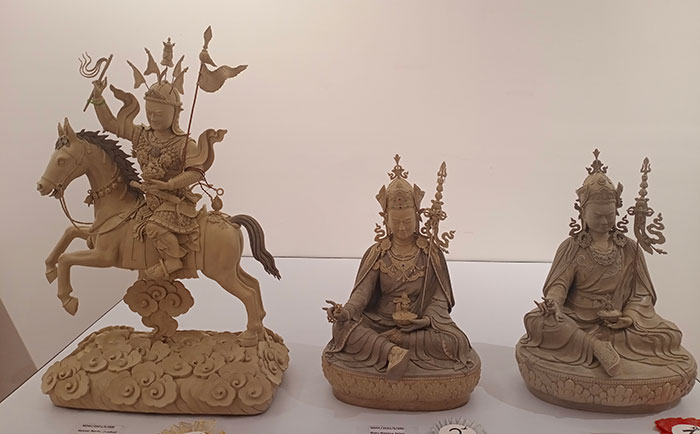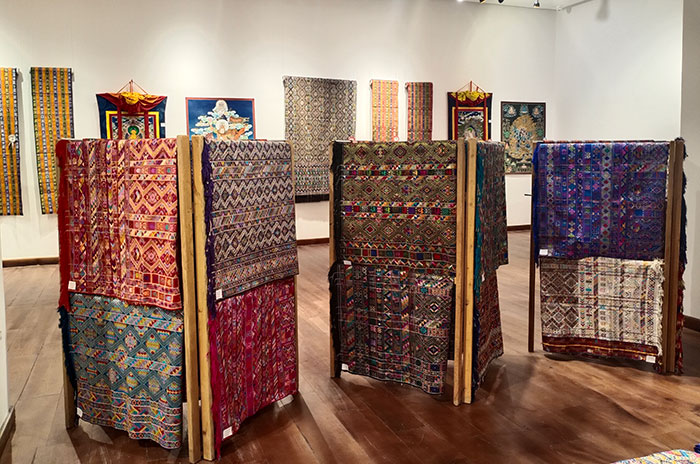Thinley Namgay
Ugyen Wangmo spent a year sitting at the loom, her back bent and fingers working intricate colourful designs. It took a lot of patience, perseverance and even more hard work to finish weaving a kishuthara.
But all that hard work paid off. The 37-year-old weaver from Khoma in Lhuentse, a place popular for the kira, is one of the winners at the 19th National Design and Arts Competition (NDAC).
Royal Textile Academy (RTA) in collaboration with the Textile Museum under the Department of Culture organised the two-day competition on March 8 in Thimphu.
This year’s NDAC saw 190 entries from across the country in seven categories comprising 25 ghos, 63 kiras, 10 embroidery pieces, six traditional paintings, 11 sculpture works, 16 wood carvings, and 59 contemporary arts.
Ugyen Wangmo said: “I expected to come first this year. Last year, I was only second. To make it more attractive, I added korma (flower pattern) this year.”
Ugyen would sell her kira at Nu 275,000.

The best entries in sculpture category
“I am glad the competition encouraged me to work harder. Since childhood, I have been weaving. This is my main source of income to look after my two children. I don’t want to give up on what I do to stand myself in life,” said Ugyen Wangmo.
The contemporary art category is organised in collaboration with VAST Bhutan. A panel of seven judges judged each category.
A 47-year-old Norbu Wangmo from Trashigang came first in the gho category. She wove lungserma gho. “It took four months to complete. Although I am a divorcee, I survive by weaving. I usually sell such a gho at Nu 180,000.”
Neten Phuntsho, 32, from Mongar, bagged the first position in the sculpture category. He made a clay statue of Ling Geyser Gyalpo in two months.
Neten Phuntsho said that such sculpture work had to be done based on religious scripture. “I did lots of background reading to understand properly, which is challenging.”
“Sculpture culture is dying in most of the dzongkhags where only a few youths take part in it. I learnt sculpture works two decades back and I am ready to impart my skills to other interested youth,” said Neten Phuntsho.
Rada, Tshewang Pema, Ugyen Lhamo, Meto Pema, and Yeshi Pelden won in the embroidery category. Dorji Wangdi won in the traditional painting, Tselthrim Tenzin and Tashi Tobden in wood carving, and Wang Rana Gurung in contemporary art.
RTA’s Executive Director, Rinzin O Dorji, said that the objective of this annual competition was to encourage artists to continue to create fine traditional and contemporary art and to provide the appropriate national recognition and publicity for their work.
NDAC is an annual competition funded by the government and American couple Alan and Patricia Bickell, who often visit Bhutan.
Rinzin O Dorji said, “RTA uses all forms of advertising to increase participation. For instance, we advertise on the radio and BBS to reach out to the people in the far-flung areas. Every year we have seen marked improvements in the standard of items submitted.”
However, Rinzin O Dorji said that our local products are hand-made by skilled artisans often taking months if not years to produce a piece. “The demand and supply of these traditional products are limited due to our small population and an even smaller percentage of people working in this sector. These factors play a role in determining the final price of the product.”
The top three winners in each category will get a cash prize of Nu 120,000, Nu 65,000 and Nu 32, 500 respectively.


